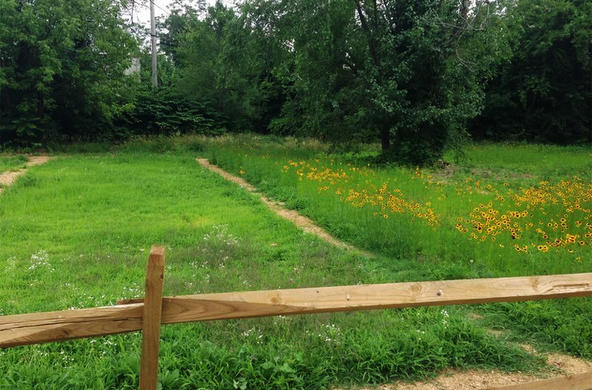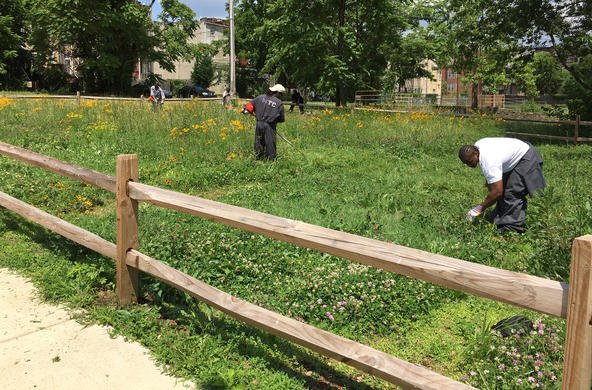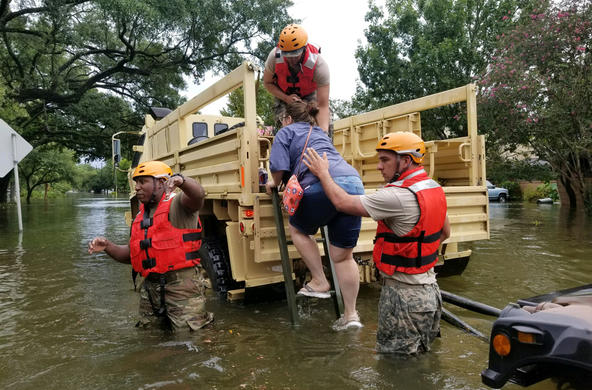Many cities are working to create new green spaces, but success is mixed. Greening projects are often expensive and labor-intensive. This can be a barrier to greening in low-income communities. For projects that enjoy a strong start, insufficient planning for long-term maintenance is common.
New research led by Cary postdoctoral associate Elsa Anderson found that plant biodiversity can be increased with broadcast seeding. This low-maintenance and inexpensive planting method is an effective way to establish native plant communities in vacant urban lots. The study was recently published in the journal Ambio.

Anderson says, “Vacant lots occupy 16% of urban land across the US. Each pocket of abandoned space is an opportunity to improve the ecological health of the surrounding neighborhood for residents and wildlife. Here, we tested a variety of planting methods in hopes of identifying a low-cost, low-effort strategy to establish native plants in vacant urban lots – adding benefits of green spaces without costly long-term maintenance, or putting residents’ housing at risk.”
Urban green spaces can yield many benefits, but there are management and equity concerns. Greening projects that are established but not maintained can become overgrown, burdening the surrounding community. On the other hand, lavish investment can transform a neighborhood, incite gentrification, and eliminate affordable housing. New York’s High Line, a disused train line turned park, is an example of this effect.
The study focused on establishing native plants, which come with many advantages. Not only are many species of native plants easy to maintain – they’re designed to thrive in their home habitat – they also support native wildlife and promote biodiversity. Even small native plant communities can provide vital habitat for birds, pollinators, and other animals.
Greening vacant lots can serve people too. Plants absorb storm water, clean pollution from the air, cool hot city streets, and offer a glimpse of nature – benefitting residents’ physical and mental health. A colorful cluster of wildflowers can go a long way in brightening a city block.
The study tested four methods of seed planting, which varied in associated cost, labor, and maintenance needs, to see which yielded the highest target species diversity and floral abundance. These methods included: seed bombing, broadcasting, planting plugs, and gardening.
Seed bombs are balls of soil, clay, and seeds, which are dispersed over soil and left to germinate. Broadcasting involves spreading seeds over the desired planting area. Planting plugs involves planting seedlings grown together in clusters. Gardening is the most expensive and labor-intensive method, requiring consistent weeding and watering.
Study sites included eight replicate test gardens planted in two locations on the University of Illinois at Chicago campus. Four test gardens were established on a vacant lot adjacent to a parking garage; the others were sited on land that is part of the UIC Plant Research Laboratory. Both locations started as seeded turf before being planted for this study.
Each test garden was divided into four subplots: one for each planting method. Three of the four subplots in each test garden were tilled before planting; one was left as turf to accommodate the seed bombing treatment. All sites received plenty of sunlight, little foot traffic, and minimal surrounding maintenance.
Each plot was either sowed with seeds or planted with plugs containing equal proportions of eight native species: black-eyed Susan, white prairie clover, pale purple coneflower, purple coneflower, stiff-leaved goldenrod, western sunflower, switchgrass, and butterfly weed. Species were chosen to represent a range of bloom times, aesthetic traits, and flower colors.
Over the course of three growing seasons, the team evaluated plant success by measuring the abundance, diversity, and height of planted species in the plots, as well as the diversity and height of non-target species.
The team found that broadcast seeding yielded the most diverse plant communities, while intensive gardening produced the most blooms and stems. Plots planted with plugs fared moderately, but some species, especially butterfly weed and white prairie clover, experienced high mortality. Broadcasting, plugs, and gardening yielded plants of similar heights. Seed bombing was ineffective by all measures.

Anderson says, “We were surprised to find that broadcast seeding resulted in higher target plant diversity than planting plugs or gardening. This is exciting because broadcast seeding is easy and cheap. We know that gardening ‘works’, and it could be appropriate for small projects, but this study shows that broadcasting could be a viable way to increase biodiversity of native plants at scale.”
Biodiversity is where broadcast seeding scored big. Monoculture plantings such as lawns, and assemblages of non-native species, do not provide the same services, nor do they support wildlife, as effectively as diverse communities which include native plants. This study provides evidence that simple broadcast seeding is an easy way to bolster native plant diversity in vacant lots.
A top takeaway: planting method matters. Anderson explains, “Three years after establishment, we saw significant differences in target plant success – in abundance and diversity – among our plots. This shows that planting method has long-term ecological consequences. Our findings can inform decisions on what planting method might be best suited for a particular site. Gardens created by broadcasting look ‘wild’, so they might not be ideal for a site where tidiness is the aim. But for covering swaths of vacant land with rich native plant communities – broadcast seeding is a great option.”
There’s good news for wildlife too. Anderson says, “It was heartening to see that already, there are lots of insects using the plants in our study plots. We spotted butterflies, grasshoppers, beetles, and bees – there was a lot of action out there.”
Next, the team will explore effects of greening method on soil ecosystem services.
Citation
Anderson, E.C., Minor, E.S. Assessing four methods for establishing native plants on urban vacant land. Ambio (2020). https://doi.org/10.1007/s13280-020-01383-z







